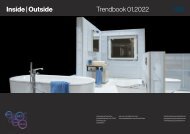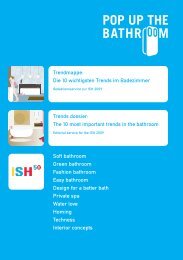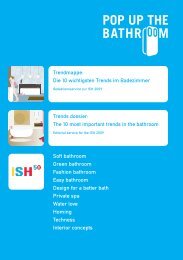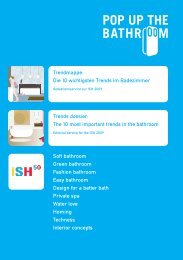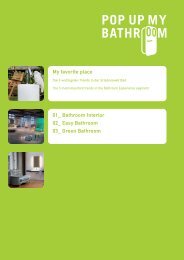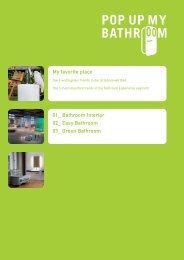My favorite place - Trendbook Pop up my Bathroom | Issue 01/2011 ISH 2011
Today’s bathrooms are no longer chilly, wipe-clean functional cells. Bathrooms are turning into living space. As simple as this meanwhile ubiquitously manifest megatrend might sound, its impact on the sanitary industry and the conceptual possibilities for bathroom design are nothing short of revolutionary. As a result, expectations of the aesthetics and functionality of contemporary bathroom design are growing. Accordingly, there will be more than “just” new products on show at the world’s leading fair for the sanitary industry, the ISH in Frankfurt. For it is not the bathtub that is being reinvented, but the entire bathroom.
Today’s bathrooms are no longer chilly, wipe-clean functional cells. Bathrooms are turning into living space. As simple as this meanwhile ubiquitously manifest megatrend might sound, its impact on the sanitary industry and the conceptual possibilities for bathroom design are nothing short of revolutionary. As a result, expectations of the aesthetics and functionality of contemporary bathroom design are growing. Accordingly, there will be more than “just” new products on show at the world’s leading fair for the sanitary industry, the ISH in Frankfurt. For it is not the bathtub that is being reinvented, but the entire bathroom.
You also want an ePaper? Increase the reach of your titles
YUMPU automatically turns print PDFs into web optimized ePapers that Google loves.
Vergleichsweise leicht haben es Anhänger des<br />
Green <strong>Bathroom</strong> bei der Materialwahl ihrer sanitären<br />
Ausstattung: Es gibt kaum ein Material,<br />
das produktionstechnisch und baubiologisch<br />
unbedenklicher sowie qualitativ haltbarer ist<br />
als Sanitärkeramik. Höchstens die Badewanne<br />
oder Duschfläche aus Stahlemail ist noch unverwüstlicher<br />
und langlebiger. Bei von einigen<br />
Herstellern gewährten Garantien von bis zu 30<br />
Jahren erscheint sogar die energieaufwändige<br />
Stahlemailproduktion wieder in einem versöhnlicheren<br />
Licht. Das macht deutlich, wie wichtig<br />
zeitloses Design und Qualitätsprodukte im Bad<br />
sind – denn das nachhaltigste Bad ist eines, das<br />
lange hält und ebenso lange schön ist.<br />
Die „natürlichen“ Eigenschaften der Keramik –<br />
hygienisch, pflegeleicht, langlebig – werden<br />
durch eine der von manchen Markenherstellern<br />
angebotenen eingebrannten Hightech-Glasuren<br />
noch erhöht. So kann etwa auch das so ursprünglich<br />
wirkende Waschbecken Bacino (Duravit) mit<br />
einer WonderGliss-Oberfläche ausgestattet werden.<br />
Ihr schmutzabweisender Effekt ist bekanntlich<br />
der Lotusblume abgeschaut. Pflegeaufwand<br />
und damit auch der Wasser- und Reinigungsmitteleinsatz<br />
werden minimiert – wiederum ein<br />
Plus für Badnutzer und die Umwelt.<br />
Doch irgendwann wird auch das schönste<br />
Waschbecken ausgemustert. Und was dann?<br />
Keine Sorge, Keramik ist vollständig recycelbar:<br />
Ähnlich wie bei der Glasherstellung werden<br />
bei der Keramikproduktion alte Keramikscherben<br />
wieder eingesetzt, und der Rest landet im<br />
Bauschutt und wird als Füllmaterial verwendet.<br />
Denn Keramik besteht ha<strong>up</strong>tsächlich aus Quarz,<br />
Feldspat, Ton und Kaolin (einem Verwitterungsprodukt<br />
von Feldspat, auch Porzellanerde genannt).<br />
Feldspate und Quarze gelten als die<br />
wichtigsten gesteinsbildenden Minerale der<br />
Erdkruste. Letztlich bleibt von der Keramik<br />
also nichts als zermahlener Stein.<br />
Text: Frank A. Reinhardt<br />
48<br />
house and of such enduring quality as sanitary<br />
ceramic. At the most, the steel enamel bathtub<br />
or shower tray might be even more hard-wearing<br />
and durable. The fact that some manufacturers<br />
guarantee their products for <strong>up</strong> to 30 years<br />
makes even the energy-intensive process required<br />
to produce steel enamel appear in a<br />
more acceptable light. All of which goes to<br />
show just how important timeless design and<br />
top-quality products are in the bathroom – for<br />
the most sustainable bathroom of all is one that<br />
will last a long time and stay just as attractive as<br />
the day it was installed.<br />
Similarly to the way glass is manufactured,<br />
shards of old material are re-used to produce<br />
new ceramic; the rest ends <strong>up</strong> as building rubble<br />
and is used as a filler. For ceramic largely<br />
consists of quartz, feldspar, clay and kaolin (a<br />
weathering product of feldspar, also known as<br />
china clay). Feldspar and quartz are considered<br />
the most important rock-forming minerals in<br />
the earth’s crust. In the end, all that’s left of the<br />
ceramic ware is a handful of crushed stone.<br />
Text: Frank A. Reinhardt<br />
The “natural” properties of ceramic – hygienic,<br />
easy to clean, long-lasting – can be further enhanced<br />
by the high-tech burnt-in glazes available<br />
from various brand-name manufacturers.<br />
Even such an elemental-looking washbasin as<br />
Duravit’s Bacino model can be equipped with a<br />
WonderGliss finish. Its dirt-repellent effect, inspired<br />
by the lotus flower, minimises the cleaning<br />
effort required and thus also the amount of<br />
water and cleaning products used – a bonus for<br />
both the bathroom user and the environment.<br />
But eventually even the most beautiful washbasin<br />
is decommissioned. And what then?<br />
Not to worry: ceramic is totally recyclable.



